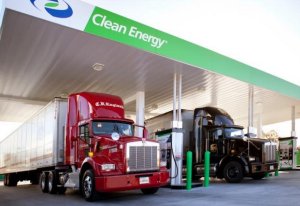 Learning about any of the clean transportation technologies involves a lengthy learning curve. It’s good for all of us to stay current and refresh the ABCs once in a while. Natural gas vehicles is a great topic to research and share educational content on, as it’s spreading out widely to vehicles and fueling stations across the US and several other markets around the world. So here are a few topical categories to cover (and please post comments if I missed anything or got it wrong)……
Learning about any of the clean transportation technologies involves a lengthy learning curve. It’s good for all of us to stay current and refresh the ABCs once in a while. Natural gas vehicles is a great topic to research and share educational content on, as it’s spreading out widely to vehicles and fueling stations across the US and several other markets around the world. So here are a few topical categories to cover (and please post comments if I missed anything or got it wrong)……
Fuel stations:
- Number of compressed natural gas (CNG) stations in the US: 1,389
- Number of liquefied natural gas (LNG) stations in the US: 150
CNG vs. LNG:
- CNG is used in light and medium duty cars and trucks, while LNG is used mainly in heavy duty trucks.
- LNG only needs 30% of the space that CNG uses for on-board vehicle storage for the same amount of energy. LNG requires on-board storage in thermal tanks capable of keeping the fuel at -260 degrees Fahrenheit. LNG vehicle conversions and their fueling stations are much more expensive than CNG.
- CNG needs to be stored on-board in a cylinder tank at 3,000 to 3,600 pounds per square inch.
Vehicle powertrains: Very similar to gasoline and diesel powered engines as they basically do the same thing with ignition of the fuel to power the engine. Conversions need to be made for the fuel storage tank, fueling receptacle/nozzle, and in the engine.
Hydraulic fracturing (“fracking”): The question of whether shooting water into gas fields to extract natural gas is environmentally safe is being fought out in several state capitals, but it’s never really been affiliated with natural gas vehicles. The criticism has to do with how the natural gas is removed from the ground and harmful consequences it could cause – tainting aquifers, causing earthquakes, and using way too much water. UC Berkeley physics professor Richard Muller contends in a paper that environmentalists should embrace hydraulic fracturing as a means to mitigate climate change and ease air pollution.
Vehicle acquisitions: Clean Energy Fuels Corp. just reported that customers using its fueling stations ordered 70% more NGVs in the first nine months of 2013 compared to the same period in 2012. The company said Cummins Westport thinks it will make 2,400 natural gas engines this year and 10,000 next year. On the retail side, there’s the Honda Civic NGV and CNG-powered pickups from Chrysler, Ford, and GM – some of them bi-fuel and some pure natural gas. Honda is reporting its sales numbers – 2,080 units for this year had been sold through the end of November. One of the strongest appeals for NGVs, especially among fleets, is that even though the acquisition cost is higher for an NGV compared to a similar non-NGV, the fuel expense is about one third that of petroleum. While the acquisition cost is higher for the natural gas vehicle, the fuel savings delivers lifecycle operating cost savings usually within two-to-three years.
Renewable natural gas: Natural gas coming from renewable sources, or biomethane, is gaining traction, especially in California where it’s eligible for low carbon credits; and sometimes it qualifies for the US Environmental Protection Agency’s Renewable Identification Numbers and its credit system. Fair Oaks Farms, based in Fair Oaks, Ind., won a 2013 NGV Achievement Award last month. AMP Americas works with Fair Oaks Farms to fuel its 42 milk delivery tanker trucks with renewable natural gas (RNG). In 2012, they set up a biodigester that processes agricultural waste to produce RNG. There are several other waste (biomass) sources being analyzed to produce RNG/biomethane from organic matter. (RNG is also called biogas.)
Emissions: NGVs are cleaner than vehicles powered by gasoline or diesel, though the figures vary. It tends to be considered to have about 25% less in greenhouse gas and carbon emissions than petroleum; and an even higher percentage in reductions of smog-creating tailpipe emissions that include hydrocarbons, nitrogen oxides, carbon monoxide, and particulate matter.
Thanks to NGV America, US Dept. of Energy, Transport Topics, HybridCars.com, and Clean Cities for data and information.




As far as I can see your information is correct. However, the question is: What about the unavoidable methane slip in the entire life cycle from methane source to CNG/LNG vehicles’ tailpipes? GTL (Gas To Liquids) i. e. a today simple chemical transformation making ethane to methanol or DME could totally quit the harmful methane slip (costly and furthermore, methane is a greenhouse gas 23 times worse than carbon dioxide). The combustion itself is as clean for methanol and DME as for methane. All three have excellent combustion characteristics.
If methanol and DME was allowed to compete att the pump and the automotive industry would produce cars capable of triflexfuel GEM (Gasoline, Ethanol, Methanol) and DME compatible diesel engines, America could get rid of foreign oil.
That’s a very good point. I forgot about the methane concerns expressed about it. It’s one of the “transparency” reporting issues that comes up in regulatory debates in state capitals.